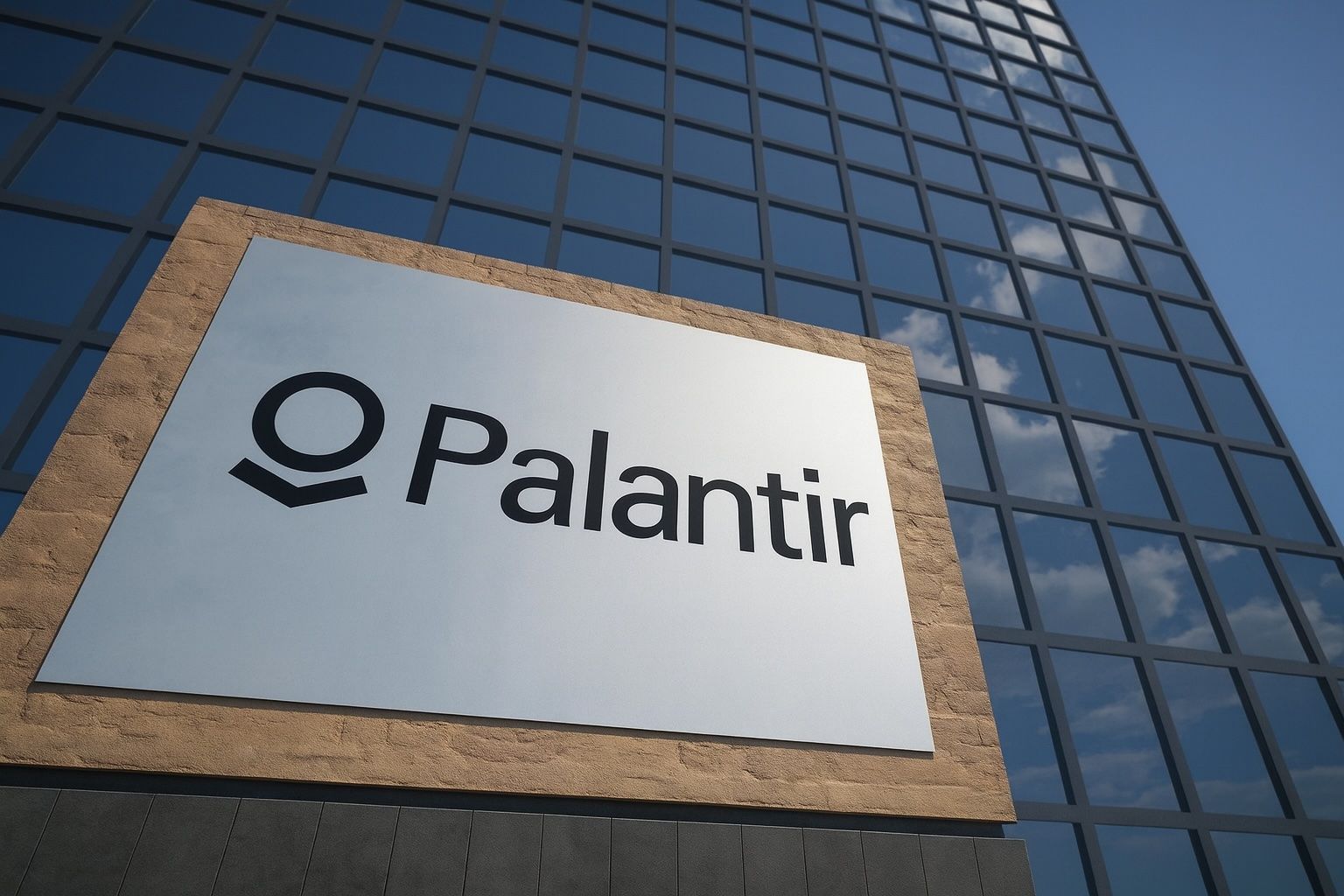- Red-Hot Rally: Palantir Technologies (PLTR) stock is trading around $179–$180 on Oct 15, 2025, after a meteoric surge this year (up roughly 3x in 2025, +360% year-on-year) – making it one of the S&P 500’s top performers [1].
- AI-Fueled Deals: The company is riding an AI boom with blockbuster contracts – including a U.S. Army deal worth up to $10 billion over 10 years and a £750M UK defense partnership – plus new commercial tie-ups in healthcare, energy, and aerospace [2] [3].
- Earnings Momentum: Financials are strong. Q2 2025 marked Palantir’s first $1 billion quarter (revenue +48% YoY) with solid profit, prompting management to raise full-year revenue guidance to ~$4.15 billion [4] [5].
- Volatility & News: Shares saw wild swings recently – a leaked Army memo on security flaws sent PLTR down ~7.5% [6], but the drop proved temporary as issues were addressed and the stock quickly rebounded [7]. Palantir also announced new AI partnerships in healthcare and energy, keeping investor excitement high [8].
- Analyst Split: Experts are divided. Bulls hail Palantir as an AI winner (Wedbush even sees an “all-night party” just getting started) [9] [10], while bears warn the valuation is “absurd” – Citron Research pegs fair value around $65 [11] [12]. The consensus rating is Hold with 12-month price targets ranging widely ($45 to $215) and a median around $150–$160 [13] [14].
Palantir’s Stock Soars Amid AI Boom
Palantir’s stock has been on fire, skyrocketing in 2025 thanks to intense enthusiasm for artificial intelligence applications. As of mid-October, PLTR hovers near $180 per share, not far below its all-time high of $190 set in August [15]. The stock has rallied dramatically over the past year – roughly +300% in 2025 alone – vastly outperforming the broader market. “Palantir shares [are] around $175… making PLTR one of the hottest large-cap tech stocks,” noted tech news site TS2 in a recent analysis [16]. This momentum has vaulted Palantir into the ranks of the most valuable tech companies, with a market capitalization around $425–$430 billion.
Recent Trading Trends: After hitting its peak in August, Palantir experienced a mild pullback. Over the last few weeks, shares have seesawed in the mid-$170s amid heavy trading volume. On Oct 3, news of a Pentagon tech “security scare” knocked the stock down by 7% in one session [17]. However, by Oct 15 Palantir had regained ground, trading back near $180. The stock’s resilience is drawing attention – it remains in a strong uptrend, with traders eyeing technical support around the 50-day average (~$150) as a floor [18]. In short, despite some volatility, Palantir is still riding high on bullish sentiment.
Big Contracts and AI Partnerships Drive Growth
Palantir’s surge is underpinned by a series of major contract wins and partnerships that underscore its growing influence in both government and industry:
- $10 Billion U.S. Army Deal: In late July, the U.S. Army consolidated dozens of projects into a single enterprise agreement with Palantir – a deal valued up to $10 billion over 10 years [19]. This Indefinite Delivery/Indefinite Quantity (IDIQ) contract (essentially a long-term umbrella deal) signals the Army’s deepening reliance on Palantir’s software. It was a landmark win that cemented Palantir’s role as a critical defense technology provider.
- UK Ministry of Defence Partnership: In September, Palantir won its largest non-U.S. contract ever – a £750 million (~$950M) deal to deploy its AI platform across the UK’s defense and security operations [20]. This five-year partnership is roughly 10× larger than Palantir’s previous UK business, highlighting surging demand from U.S. allies for Palantir’s technology. The timing (announced during a high-profile US-UK meeting) underscored Palantir’s rising geopolitical profile [21].
- “Game-Changing” Boeing Alliance: On Sept 23, Boeing’s Defense & Space division announced it will integrate Palantir’s AI-driven data platform across its manufacturing and aerospace programs. Boeing’s defense chief Steve Parker called the partnership “game-changing,” saying Palantir’s system enables decisions “not in weeks, but in days and hours” by leveraging AI [22]. Palantir’s stock jumped ~2% on that news [23], as analysts saw it as a strong vote of confidence from a top defense contractor.
- Healthcare & Energy Expansion: Palantir is rapidly extending its reach beyond defense. Just this month (Oct 6), healthcare analytics firm OneMedNet selected Palantir’s AI Platform (AIP) to power a real-time data network for hospitals and researchers [24]. OneMedNet’s CEO praised Palantir’s AIP for delivering “high-quality, regulatory-compliant data at remarkable speed,” enabling AI-driven breakthroughs [25]. In energy, Palantir inked a deal to build an AI “Nuclear Operating System” for a nuclear power project (~$100M value) [26]. The company is also deploying its Foundry data platform with new clients in automotive (like Fiat) and government healthcare (the UK’s NHS), showing broadening adoption across sectors [27].
These big deals illustrate why investors are excited – Palantir’s software is becoming embedded in critical operations from the battlefield to hospitals. The steady drumbeat of contract announcements has provided fundamental support for the stock’s rally, suggesting Palantir’s AI technology is in high demand.
Earnings Beat and Financial Momentum
Palantir’s fundamentals have finally started to catch up with its stock hype, bolstering the bull case. The company turned profitable in 2023, and in Q2 2025 it delivered record results. Revenue for the quarter hit $1.03 billion (the first time quarterly sales topped $1B), representing 48% year-over-year growth [28]. GAAP net income swung to a robust $327 million (up 144% YoY) [29], signaling that Palantir’s aggressive expansion is now translating into real earnings.
Off the back of that strong quarter, management raised its full-year 2025 revenue guidance to about $4.14–$4.15 billion [30]. This upbeat outlook reflects confidence in continued demand from both government and commercial customers. “We are very, very bullish on America,” Palantir CEO Alex Karp said on the Q2 earnings call [31], emphasizing how increased U.S. federal spending on technology and defense is benefiting the firm.
The market cheered these numbers – Palantir’s ability to sustain high growth and profitability is a key reason for the stock’s surge. Its “Rule of 40” (combined growth rate + profit margin) is well above industry norms [32], indicating a rare mix of rapid expansion and widening margins. Free cash flow is strong as well [33]. In short, Palantir’s financial trajectory is finally starting to justify some of its rich valuation, though there’s plenty of work ahead to grow into a $400+ billion market cap.
Investors will be watching the upcoming Q3 2025 earnings (likely due in a few weeks) to see if momentum continues. Any slowdown or disappointment could test the stock’s lofty price, especially given how high expectations have become.
Army Security Scare and Stock Volatility
No rally is without bumps. In early October, Palantir faced a brief scare when a leaked U.S. Army memo raised red flags about a new battlefield network system Palantir is helping develop. Reuters reported that the internal Army memo flagged “fundamental security” problems in the prototype NGC2 system co-developed by Palantir and Anduril, calling it “very high risk” [34]. The memo ominously stated, “Given the current security posture… the likelihood of an adversary gaining persistent undetectable access… requires the system be treated as very high risk.” [35]. In other words, serious vulnerabilities were found – such as lack of access controls and auditing – in this early version of the communications platform.
When this news hit on Oct 3, Palantir’s stock plunged about 7–8% in a single day [36]. Investors feared a potential setback if the Army’s confidence wavered. However, the panic was short-lived. Both Palantir and its partner quickly responded, clarifying that the memo described an outdated prototype and that the issues had already been fixed in the normal development process [37]. A Palantir spokesperson emphasized “no vulnerabilities were found in the Palantir platform” itself [38], implying the problems were in third-party components and had been mitigated. By the following trading session, PLTR rebounded ~3% [39], recovering much of the lost ground as the Army and companies reaffirmed their commitment to the project.
This episode highlighted both Palantir’s volatility and the faith of its investors. Even a whiff of bad news can spark a sell-off given the stock’s high valuation. But the quick recovery showed bulls remain eager to “buy the dip” on Palantir, as long as the fundamental story (and contract pipeline) stays intact. It also underlines the risks of Palantir’s close ties to defense programs – any technical hiccup or policy change can create outsized stock swings.
Institutional Moves and Investor Buzz
Palantir’s dramatic rise has attracted significant attention from institutional investors, though opinions vary on whether the stock is a must-own or too frothy. Recent filings show some big names increasing their stakes. For example, Ritholtz Wealth Management boosted its position in Palantir by 55.9% in Q2 (adding over 11,700 shares to hold ~32,700 shares total, worth ~$4.46 million) [40]. Several other funds and advisors also added Palantir shares earlier this year [41], reflecting optimism about its long-term prospects. As a result, about 45.6% of PLTR stock is now owned by institutions and hedge funds [42] – a substantial level of institutional ownership for a relatively young public company.
At the same time, there are signs of insiders cashing out during the rally. Over the past quarter, Palantir executives have sold a notable amount of stock, raising some eyebrows. In August, co-founder and President Stephen Cohen sold ~191,720 shares at an average ~$151 (totaling ~$29 million) [43], essentially liquidating 99% of his position [44]. Chief Operating Officer Shyam Sankar likewise sold 375,000 shares (~$56.7 million worth) that month [45]. Such insider sales can be interpreted in different ways – often it’s just personal profit-taking after a big run-up, but it can also signal that even insiders feel the price is rich. These sales haven’t slowed the stock’s momentum yet, but investors are keeping an eye on insider activity as one gauge of confidence.
On the retail side, Palantir has developed a fervent following. It frequently trends on social media and trading forums; in fact, StockTwits noted PLTR was the #1 trending ticker in late August as excitement – and a bit of FOMO – swept through the retail crowd. This buzz cuts both ways: it provides fuel for the rally, but also introduces volatility as sentiment can swing rapidly on news or rumors. For now, the Palantir hype – especially around its AI narrative – remains a powerful force.
Experts: AI Goldmine or Overhyped Bubble?
The stark divide in analyst opinions on Palantir is almost as dramatic as the stock’s price swings. Wall Street and tech analysts do agree on one thing: Palantir is a unique company riding a huge trend. But is it the next tech empire or a bubble waiting to burst? Opinions differ:
- The Bulls: Optimistic analysts see Palantir as a potential big winner in the AI revolution. Wedbush Securities, for instance, has repeatedly named Palantir a “top pick” in the tech sector. Star analyst Dan Ives portrays the current AI investment cycle like an “all-night party” that’s still in the early innings – “It was 9:00 p.m., it’s now 10:00 p.m., and [the party] goes to 4:00 a.m.” he quipped, suggesting we’re still early in the AI boom fueling Palantir’s growth [46] [47]. Bank of America’s team is also bullish, recently raising their PLTR price target to $215 (one of the highest on Wall Street) after observing accelerating demand [48] [49]. Proponents argue that Palantir’s dual focus on government and commercial AI gives it “two engines” of growth [50]. They point to the company’s expanding use-cases and first-mover advantage in deploying AI solutions at scale. In their view, Palantir could be an “AI goldmine” – a company with the platform and client base to dominate enterprise AI software much like an early Salesforce or Microsoft in their domains.
- The Bears: On the other side, skeptics believe Palantir’s stock has run far ahead of its fundamentals. Notable short-seller Andrew Left of Citron Research has lambasted PLTR’s valuation as “absurd,” arguing that based on realistic metrics the stock “should be only ~$65–$70” per share [51] [52] – implying a huge downside from nearly $180. Bears note that Palantir’s core government market, while lucrative, can be lumpy and slow-growing, and that competition in enterprise data platforms is rising. They highlight Palantir’s stretched financial ratios: for example, the stock trades at over 110× forward sales and 210× earnings, multiples that dwarf other high-growth software names [53]. Even some tech CEOs have poked fun at Palantir’s rich pricing – Salesforce’s Marc Benioff joked that Palantir is so expensive, it’s “the most expensive enterprise software I’ve ever seen,” noting it trades at ~100 times revenue [54]. The bear case is essentially that Palantir = great company, crazy stock price. Any stumble – a missed earnings quarter, a lost contract, or broader market pullback – could trigger a sharp correction given how much optimism is baked into shares [55].
Wall Street Consensus: The clash of perspectives results in a fairly mixed consensus. According to MarketBeat and other survey sources, Palantir currently has 5 “Buy” ratings, 15 “Hold”, and 2 “Sell” [56]. In other words, most analysts are on the sidelines with a neutral stance, even as a few bulls and bears tug in opposite directions. The average 12-month price target for PLTR hovers around $140–$155, which is below the current trading price [57] [58]. That suggests many analysts think the stock may have gotten a bit ahead of itself in the near term. Price targets range extremely widely – from under $50 at the low end to $200+ at the high end [59] [60] – reflecting the high uncertainty about how Palantir will ultimately justify its valuation. It’s rare to see such a large company with this level of disagreement on its outlook, which speaks to Palantir’s unusual position at the crossroads of big data, AI, and government tech.
Outlook: High Hopes vs. High Valuation
Going forward, Palantir finds itself at a crossroads of excitement and expectation. On one hand, the company is firing on all cylinders: revenue is soaring, it’s landing huge contracts, and it has carved out a reputation as a leader in cutting-edge AI applications. Palantir’s bold claim of being the “operating system for the modern enterprise in the era of AI” seems less hyperbole and more reality with each new partnership. Broader market trends also favor Palantir – governments and businesses are pouring money into AI and data analytics, a multi-hundred-billion dollar market opportunity that Palantir is well positioned to capture [61].
On the other hand, investors must weigh the price they’re paying for this growth. At ~$180 per share, Palantir is valued like few other companies, trading at revenue and earnings multiples that assume many years of blistering growth ahead [62]. Any indication that growth is slowing – or that competition is catching up – could deflate the stock’s premium. Moreover, as an “AI darling” stock, Palantir could be vulnerable if the broader tech market stumbles or if interest rates rise and make high-flying tech valuations less palatable. In such scenarios, even great companies can see their stock prices pull back sharply.
For now, Palantir’s story in October 2025 is one of remarkable momentum. The stock’s trajectory has rewarded believers, but it also carries the echoes of past tech hype cycles. Is Palantir the next tech titan or the next bubble? The answer may lie in whether the company can continue executing on its big opportunities. In the near term, upcoming earnings and the pace of new contract wins will be key signals. As ts2.tech observed, Palantir encapsulates both the “AI goldmine excitement and bubble risk” of today’s market [63]. For investors and onlookers, Palantir’s ride is a thriller – with fortunes to be made, but also plenty of white-knuckle moments on the journey ahead.
Sources: Recent analyses from TechStock² (ts2.tech) [64] [65]; Reuters [66]; MarketBeat [67]; and other financial media.
References
1. ts2.tech, 2. ts2.tech, 3. ts2.tech, 4. ts2.tech, 5. ts2.tech, 6. ts2.tech, 7. ts2.tech, 8. ts2.tech, 9. ts2.tech, 10. ts2.tech, 11. ts2.tech, 12. ts2.tech, 13. ts2.tech, 14. www.marketbeat.com, 15. ts2.tech, 16. ts2.tech, 17. ts2.tech, 18. ts2.tech, 19. ts2.tech, 20. ts2.tech, 21. ts2.tech, 22. ts2.tech, 23. ts2.tech, 24. ts2.tech, 25. ts2.tech, 26. ts2.tech, 27. ts2.tech, 28. ts2.tech, 29. ts2.tech, 30. ts2.tech, 31. ts2.tech, 32. ts2.tech, 33. ts2.tech, 34. ts2.tech, 35. www.reuters.com, 36. ts2.tech, 37. ts2.tech, 38. ts2.tech, 39. ts2.tech, 40. www.marketbeat.com, 41. www.marketbeat.com, 42. www.marketbeat.com, 43. www.marketbeat.com, 44. www.marketbeat.com, 45. www.marketbeat.com, 46. ts2.tech, 47. ts2.tech, 48. ts2.tech, 49. ts2.tech, 50. ts2.tech, 51. ts2.tech, 52. ts2.tech, 53. ts2.tech, 54. ts2.tech, 55. ts2.tech, 56. www.marketbeat.com, 57. www.marketbeat.com, 58. www.marketbeat.com, 59. ts2.tech, 60. ts2.tech, 61. ts2.tech, 62. ts2.tech, 63. ts2.tech, 64. ts2.tech, 65. ts2.tech, 66. www.reuters.com, 67. www.marketbeat.com










